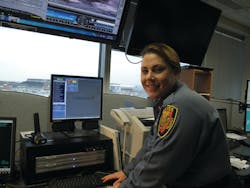Transit Police Look for Secure Information Sharing
With large events, threats of terrorism, natural disasters and other safety issues facing transit police across the U.S., officials are looking for more ways to protect their riders and work with other police agencies to combat crime.
Often times it can be difficult for transit police to get information from other agencies because of concerns other departments or rescue workers may have with sharing all of the information they have, so more agencies are turning to equipment that allows police to communicate privately with other departments and share only what they wish.
“It’s an extra tool for us,” NJ Transit Police Lt. Maryelyn Conway said. “It doesn’t tie up our radios.”
Joe Mazzarella, senior vice president and chief legal counsel for Mutualink, which makes information sharing equipment for police agencies, said the system works on a concept of interoperable response where agencies work together in order to handle crisis and use their resources in order to leverage the best response possible to an emergency situation. Transit agencies can share information with police and fire officials, who can also share information with area hospitals involved in the event.
Mazzarella said the system works in line with human behavior to want to protect information and allows agencies to keep sovereignty of its information.
“They want to cooperate,” he said. “But they want to cooperate in a way not hampering or harming their own missions.”
Because information can be shared on an ad-hoc basis, Mazzaarella said it also takes away some of the issues inherent with different government agencies sharing information, such as privacy issues and the concern about who takes care of the main infrastructure.
Communication between agencies becomes even more critical in areas where people are more dependent on mass transit, Mazzarella said, because it’s one of the foundational blocks of society and can cause an area to break down in the event of a mass emergency if it fails.
“It builds relationships that wouldn’t normally be there in the past,” said Rob Wright, business development director for Mutualink. “Now in an emergency with that communication going back and forth, it makes the users feel more comfortable talking to those people and that has been one of our goals.”
Wright said in northern New Jersey, his company saw two major cities — Newark and Jersey City — where NJ Transit operates alongside multiple police agencies and other transit agencies, such as the Port Authority Trans-Hudson Corporation (PATH) train and the communication between agencies in the event of an emergency were enhanced by the addition of the information sharing equipment.
Wright said they did an active shooter drill at a mall Jersey City two years ago and the addition of the easier sharing ability between agencies and how they operate when a situation like that hits.
“We like to say there are a lot of different tools out there, but one thing that’s unique about Mutualink is we’re not another tool being used,” he said. “We’re the tool box.
Conway said using such a system helps officers because it saves time by allowing a direct, secure line of communication with other police agencies in the region. It also clears up radio lines during events, which helps officers on patrol.
NJ Transit officers use the Mutualink system on a nearly weekly basis for football games or other large events taking place at The Meadowlands, Conway said, where NJ Transit has a station and a lot of people will be present.
“From a security standpoint, this is a secure line, so it’s private and other people can’t listen in on us,” she said. “It’s very important to us because anyone with a scanner can listen in on our channels.”
